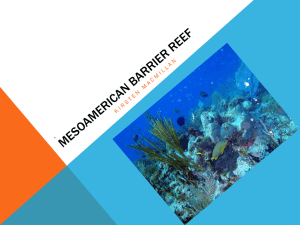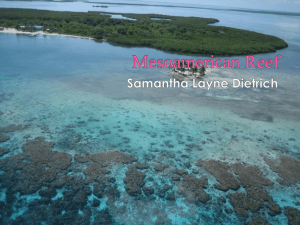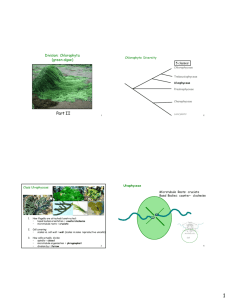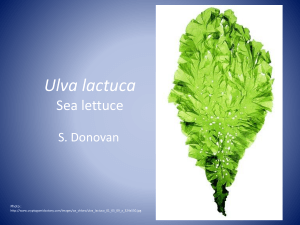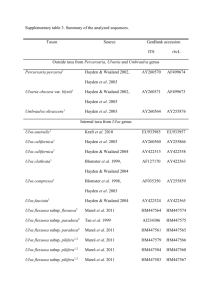Lecture 8 – Mar 20
advertisement
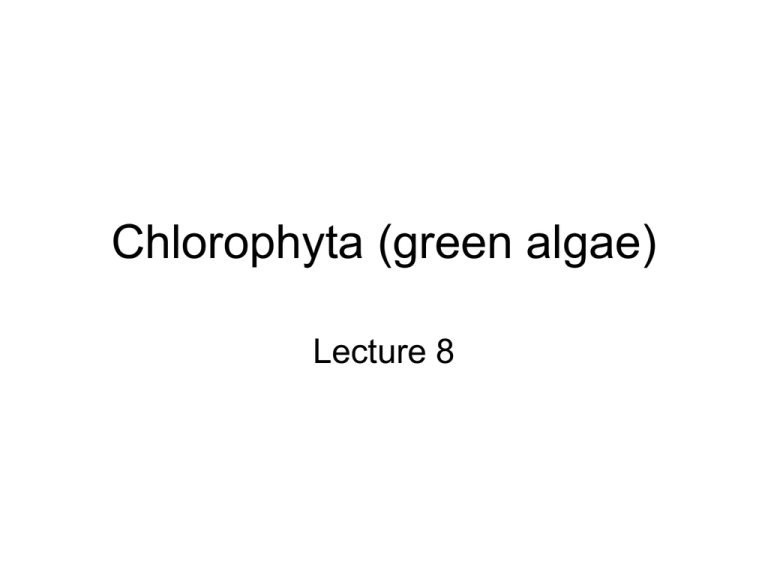
Chlorophyta (green algae) Lecture 8 OVERVIEW Eubacteria & Protists • Cyanophyta • “Phytoplankton” • Chlorophyta, Phaeophyta, Rhodophyta Vascular Plants (Gymnosperms & Angiosperms) • Seagrasses – Hydrocharitaceae & Potamogetonaceae • Saltmarshes – Poaceae, Juncaceae, etc • Mangroves – Rhizophoraceae, Avicenniaceae • Beach & Dune plants Fan-Shaped Phylogenetic Tree “MACRO-ALGAE” = seaweeds • Divisions: – Chlorophyta (green) – Phaeophyta (brown) – Rhodophyta (red) • Separated on basis of pigments (color) • Evolved 900-600 Mio (Cambrian) • Continental Margins – Rocky shores or lagoons predominantly. Div Chlorophyta – Chlorophyta (green) – 900 spp (about 10% of known spp, rest are freshwater). – Ancestor of terrestrial plants (Kingdom Plantae) – Chl a + b, (B-carotene, xanthophylls – photoprotective role) – Uni-nucleate, also Multi-nucleate (siphonous) – 6 Orders: e.g. Ulvales, Cladophorales, Caulerpales – Cosmopolitan and tropicals Algal pigments Pigment Molecules CHLOROPHYLL CAROTENES Enteromorpha Epiphytes Chaetomorpha Cladophora Ulva Halimeda Enteromorpha Caulerpa THALLUS COARSLEY - BRANCHED SHEET ENCRUSTING FILAMENT JOINTED CALCAREOUS THICK LEATHERY Form - Function Incr productivity Ulva Halimeda Enteromorpha Caulerpa Why simple = more productive? • Nutrient uptake, waste removal in single cell relies on diffusion, some active uptake. • No translocation within plant necessary • Reduce boundary layer effects – promotes diffusion into cell. • No metabolic losses to structural tissues • Faster life-cycle (hrs – days) Boundary Layers • Zone of little-no flow around an object/surface. • Inhibits diffusion • Movement promotes flow past object, breaking down boundary layer • Important for algal nutrient and CO2 uptake Boundary Layers • Zone of little-no flow around an object/surface. • Inhibits diffusion • Movement promotes flow past object, breaking down boundary layer • Important for algal nutrient and CO2 uptake Diffusion across cells/membranes Simple Structure and Succession • r vs K selected lifestrategies • r = Ulva, Enteromorpha • K = Halimeda, Penicillus • Taxonomy generally from simple to complex: single cells, filaments, multi-filament, corticated, specialized structures Chlorophyte taxonomy • Number of classes has increased from 1 in 1903, to 3 in 1990, to 10 in 1995. • Based on EM (2 types of cell division, flagellum ultrastructure) and RNA sequence in chloroplast and mitrochondria, DNA in nuclei. • Ancestors of terrestrial vascular plants • Class Prasinophyceae – single cell (plankton). • Class Chlorophyceae – 6 of 15 orders have seaweeds. Thallus organization • • • • • • Unicell flagellate – Chlamydomonas Colonial flag – Volvox Tetrasporal, Coccoid, Sarcinoid groups Filamentous – Ulothrix Thallose – Ulva Siphonous - Caulerpa Evolution VOLVOX Chlamydomonas Spyrogyra Chara - muskgrass Chlorophyceae taxonomy (recent) • Or. Ulvales (Ulotrichales) – Fam. Ulvaceae + 5 others • Cladophorales – Cladophoraceae + Anadyomenaceae • Acrosiphoniales – 1 order • Siphonocladales – Siphonocladaceae, Boodleaceae, Valoniaceae • Caulerpales – Bryopsidaceae, Caulerpaceae, Codiaceae, Udoteaceae, + 2 others (FW) • Dasycladales – Dasycladaceae + Acetabulariaceae Cl. Chlorophyceae taxonomy Dawes, pg 122 Or. Ulvales Ulva Or. Ulvales Enteromorpha Or. Cladophorales Cladophora Or. Cladophorales Anadyomene Or. Siphonocladales Boodlea Siphonocladus Or. Siphonocladales Holdfast Valonia Or. Caulerpales Or. Caulerpales Or. Caulerpales Caulerpa mexicana Or. Caulerpales Or. Caulerpales Codium Or. Caulerpales - rhizophytic “root-ball” Or. Caulerpales Or. Caulerpales Halimeda Or. Dasycladales Dasycladus Batophora Or. Dasycladales Acetabularia MS Chlorophyta (1957) • Ulvales – Enteromorpha flexuosa, E. lingulata, E. plumosa, Ulva lactuca – Ulotrichaceae – Stichooccus marinus – Chaetophoraceae – Entocladia viridis, Phaeophila floridaerum, Ulvella lens • Cladophorales – Cladophora fascicularis, C gracilis, Rhizoclonium riparium. • Siphonales – Osterobium queketti • about 12 species… Chlorophyta in the “news” • Ulva and Enteromorpha abundance increases in Baltic Sea / Adriatic Sea due to eutrophication – smothering seagrass and mudflats, smelly wrack driving tourists from beaches. • Enteromorpha bloom in China largest ever recorded – thought to originate from aquaculture. • Caulerpa taxifolia – Killer Algae escapes Monaco aquarium. Covers 10’000acres in Med within <10years. • Halimeda and Dictyota (brown) smother Fla Keys reef tract – response to eutrophication from septic systems? • Acetabularia used in studies of abiotic and genetic cues for algal development. Chlorophyta in the “news” • Ulva and Enteromorpha abundance increases in Baltic Sea / Adriatic Sea due to eutrophication – smothering seagrass and mudflats, smelly wrack driving tourists from beaches. Enteromorpha bloom seen from space! (Liu et al. 2009) Enteromorpha bloom seen from space! (Liu et al. 2009) Cause: more aquaculture of seaweed (Porphyra) for sushi. Green algae a by-product. Ocean circulation moved bloom of green algae north and east, so accumulates onshore far from source population. http://aquat1.ifas.ufl.edu/seagrant/cautax2.html Chlorophyta in the “news” • Caulerpa taxifolia – Killer Algae escapes Monaco aquarium. Covers 10’000acres in Med within <10years. Chlorophyta in the “news” • Halimeda and Dictyota (brown) smother Fla Keys reef tract – response to eutrophication from septic systems? Orange Bay, Jamaica. Eutrophication from sugar cane fields SAND KEY, FLA Chlorophyta in the “news” • Acetabularia used in studies of abiotic and genetic cues for algal development. Chlorophyta and Coral reefs Coral Reefs Acropora - staghorn Acropora - Elkhorn Porites – finger coral Montastrea – boulder coral Global Distn Reef Zonation Lagoon Back-reef Reef flat Rim Spur-andgroove Slope Deep plain GBR – Heron Island Reef Plant-Animal interactions • "The Living Coral Reef is one of the most diverse and complex communities in the world". • The Florida Keys coral reef community presents approximately 107 species of corals (over 80% of all coral species of the tropical Atlantic) and over 500 species of tropical fish. • The interaction and interdependence among all these organisms is so critical that many reef inhabitants cannot live outside the reef zone (e.g. Grunts). • Sunlight, water, fish, invertebrates and plants play major roles in the sustaining and building of the reef: – – – – Sunlight --> Photosynthesis. Water --> Brings nutrients, O2, CO2. Fish --> Excrements help build and cement reef. Invertebrates and Plants --> Secrete calcium carbonate sediments that cement reef; food source; also graze the reef algae, creating space for corals to get established and grow. http://www.reefrelief.org/ecosystem.html Reef formation • Fringing reefs – Fla Keys • Barrier Reefs – GBR, Belize • Atoll reefs – Pac volcanic islands Reefs in peril 1960’s 2000’s In <40 ys more than 50% of reefs have declined globally!!!!! Importance of herbivores: fish, urchins, snails Lytechinus die-off Caribbeanwide in 1983 results in macroalgal blooms on reefs Bottom-up Vs Top-down • Coral dominance under low nutrient, high grazer abundance. • Algal dominance under high nutrient and/or low grazing. • Bottom-up = eutrophication. Algae out-grow corals and smother recruits. • Top-down = overfishing of large fish predators AND herbivores. Trophic cascade, results in too few micrograzers to check algal growth. Seen this before in seagrasses – remember Heck and Valentine 2006paper? Summary • • • • Chlorophyta – ancestors of vascular plants 10% marine, high tropical diversity Unicell -> Filamentous -> Siphonous Ulva, Enteromorpha cosmopolitan indicators of eutrophication • Coral reef algae and “alternate stable states”: eutrophication vs trophic cascade






